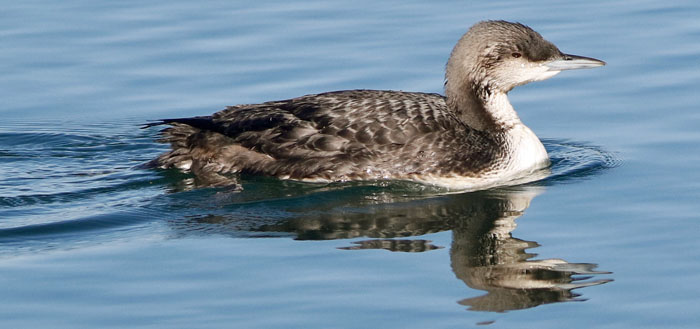
a web page by Don Roberson |
 |
||||
LOONS Gaviidae |
||||
|
||||
During the winter they sport a plain non-breeding dress like this Common Loon (left, called "Great Northern Diver" in the Old World). The pale tips to the back and scapulars suggest this individual in in juvenal plumage in its first winter. All loon species molt into a striking alternate plumage before departing for the northern breeding grounds in spring, as has this migrant Pacific Loon (below). |
||||
 |
||||
There has been much study of the breeding biology and ecology of Common Loon (right, in breeding plumage). It is the "state bird" of Minnesota and its weird echoing cry on the breeding grounds is a classic sign of wilderness there and elsewhere in the forested northlands. Because the use of motor boats on northern lakes negatively impacts breeding populations, there has been much concern for its protection. Numerous state and national efforts are underway to protect or study loons, particularly on their breeding grounds (e.g., The Loon Project, the North American Loon Fund). The plumages of loons change dramatically. We can watch these changes in Monterey harbor, California, which is an exceptional spot to view loons at close distances. It is particularly fun to watch their molts during late winter and spring. Individuals change body plumage at different paces. Th gallery below from Monterey harbor features a wintering Common Loon (upper left), a transitional individual (upper right), and one in full alternate plumage before departure (lower photo in gallery). Not only are the body plumages quite different as a loon reaches breeding condition, but bill color changes dramatically as well. |
||||
|
||||
Traditionally, loons were considered one of the oldest groups of birds and placed near the front of the taxonomic order. Some anatomical characters suggested a close relationship with grebes (e.g., Cracraft 1981), and for many decades the loons and grebes were listed next to each other in all bird books. Sibley & Ahlquist (1990) and Sibley & Monroe (1990), using DNA hybridization techniques, considered them more closely related to shorebirds and alcids, and therefore placed them somewhere in the middle of their listings (at the end of the Charadriiformes). The 1998 A.O.U. Check-List (AOU 1998) considered the latter arrangement "highly controversial" and prefers to "retain [loons] in their current position (i.e., at the front of the list) until their relationships are resolved." Those relationships are now resolved through molecular research, and we find the loons somewhere in the middle of taxonomic arrangement. Recent molecular studies show that loons are not closely related to grebes at all, but are close to penguins and procillarids (Hackett et al. 2008, Jarvis et al. 2014). Loons are well-equipped for a lifestyle lived in the water. They have lobed feet set well back — these feet are unusually large in Common Loon (below left, in juvenal plumage) — that they do not walk well of land. This alternate-plumaged Pacific Loon (below right) was oiled, so flew to a coastal freshwater lake to dry off, and could hardly move on land. Nesting adults with nests just a few feet from shore would tobaggon to and from such a nest. |
||||
|
||||
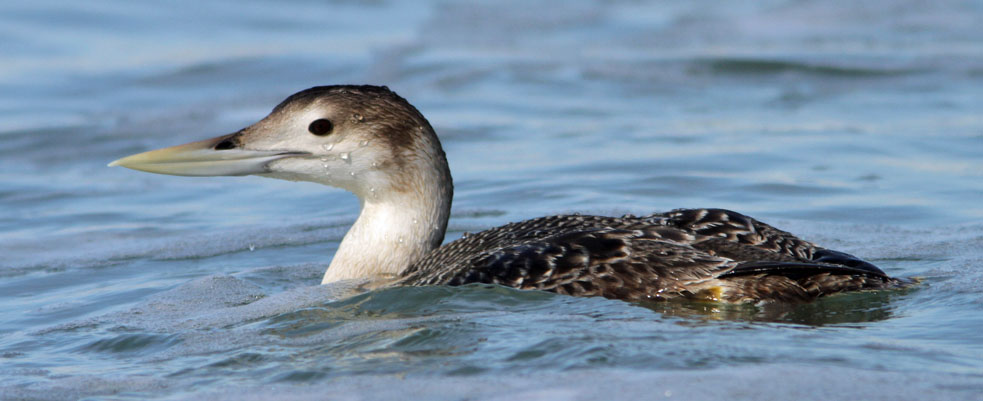 |
||||
An occasional adult has also reached Monterey Bay. This particular loon (right) was unusual as it returned to the same spot — about a half-mile offshore my hometown of Pacific Grove — for six consecutive years from winter 1993–94 to winter 1998–99. It would appear each year in November in full breeding plumage (as in this photo, right) and was always first-spotted by a fishing and whale-watching captain, the late, great Richard Ternullo, from his fishing boat. Then the loon would molt into basic plumage for the winter but would change back into breeding plumage by the time in left in March. My digitized slide from 1995 makes this Yellow-billed Loon look "white-billed." Perhaps today's digital cameras would do a better job, but this species is actually called "White-billed Diver" in the Old World. Common and Yellow-billed Loons are the biggest loons. The smallest is Red-throated Loon (below), with its thin bill, comparatively small feet, a pale plumage and a prominent white flank patch. This particular individual still is mostly in winter (=basic) plumage, but the new blackish feathers on the back with double white spots at their tips, and the streaked pattern on the lower throat, are indications that the body molt into breeding (=alternate) plumage has begun on this late April loon. |
||||
 |
||||
|
||||
In breeding plumage, Arctic Loon also differs in having a much darker gray nape than the pale gray nape shown by breeding-plumaged Pacific Loon (below). Size and bill shape differences, and the presence/absence of white flanks, are also useful in summer birds. The species apparently have differing habitat preferences for nesting, with Arctic on interior lakes and Pacific more often along the coast. In Monterey Bay, where I live, Common Loon is the loon of the harbor; Red-throated Loon prefers inshore waters over sandy bottoms, and Pacific Loon forage together in flocks over deeper waters, beyond the kelp line. Because it is the farthest loon from shores or piers, it is the most difficult loon to study closely. Yet, in fact, it is by far the most common species wintering around Monterey Bay. Statewide, some 90% of the many thousands of loons that migrate down and up the California coast in fall and spring are Pacific Loons. |
||||
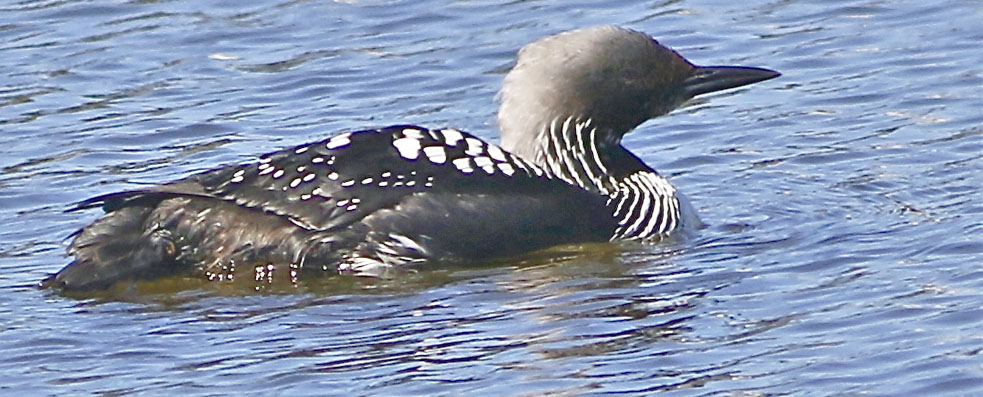 |
||||
Photos: The flight of migrant Pacific Loon Gavia pacifica was California, on 15 Jan 2006. The wintering Common Loon Gavia immer was in Monterey harbor, California, on 21 Feb 2009. The flying Pacific Loon Gavia pacifica was from a boat on Monterey Bay, California, on 20 Apr 2008. In the sequence of Common Loon Gavia immer plumages, the first breeding plumage bird was in Monterey harbor, California, on 19 Mar 1983; the basic plumaged bird was there on 31 Dec 2019; the bird in molt from basic into alternate plumage was on 6 May 2017; and the one in full alternate plumage was at Moss Landing, Monterey Co., California, on 6 Apr 2016. The red-eyed juvenile Common Loon Gavia immer was in Monterey harbor on 7 Feb 2010. The oiled, breeding-plumaged Pacific Loon Gavia pacifica was on a small mudflat at Laguna Grande Park, Seaside, California, on 25 May 2021. The juvenile Yellow-billed Loon Gavia adamsii was photographed from Del Monte Beach, Seaside, on 4 Feb 2012; the adult Yellow-billed Loon Gavia adamsii was just offshore from Lovers Pt., Pacific Grove, on 13 Nov 1995 (taken from Richard Ternullo's boat). The molting Red-throated Loon Gavia stellata was at Moss Landing on 22 Apr 2009. The juvenal Arctic Loon Gavia arctica was in the Monterey harbor on 13 Jan 2013, and the comparative, short-billed juvenile Pacific Loon Gavia pacifica was at Moss Landing on 2 Oct 2020. The breeding-plumaged Pacific Loon Gavia pacifica that concludes the page was on El Estero, Monterey, on 22 Apr 2019. All photos © Don Roberson; all rights reserved. Bibliographic note: There is no "family book" per se, although there are numerous books devoted to the Common Loon. There are numerous coffee-table "survey" books that include loons among other waterbirds. An introduction to the family, with a few fine photos, is in Carboneras (1992). Literature cited:
|
||||
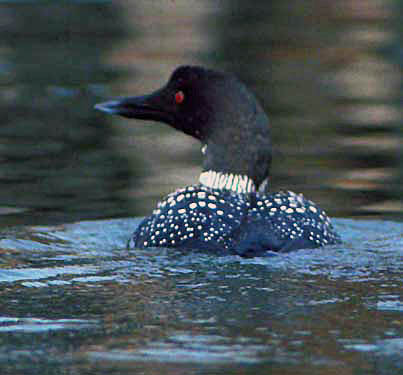
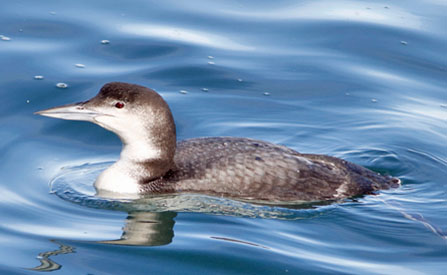
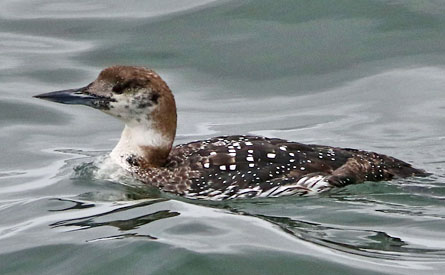
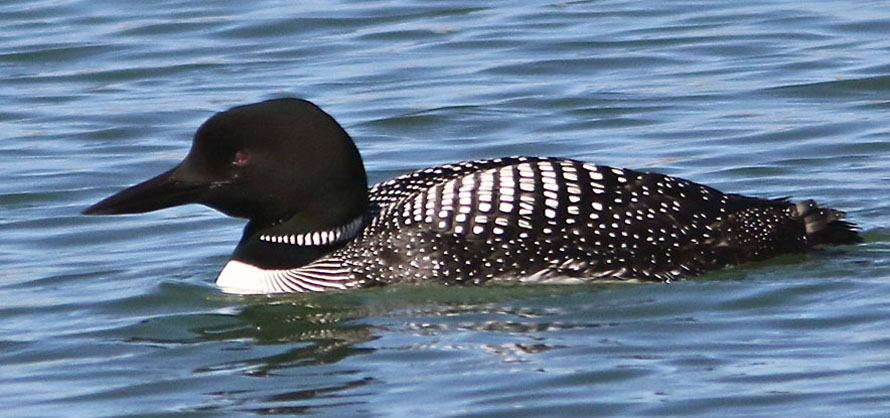


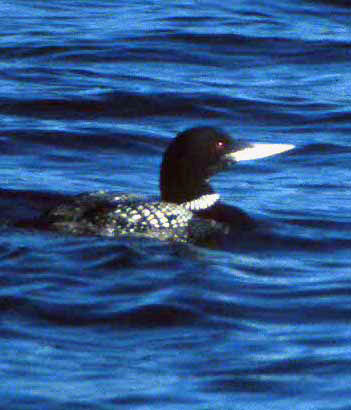 Yellow-billed Loon (above & right) is a scarce Holarctic breeder that winters southwards along the coasts of North America and Eurasia. In California, it is a rare but regular vagrant, averaging perhaps 1-2/year in 2000 (when the first version of this page was posted), but fewer than that recently with global warmer and concurrent warmer sea-water temperatures in Monterey Bay. When such a rarity arrive, most of them are juveniles. The key papers on identification and distribution of Yellow-billed Loons (Binford & Remsen 1974, Remsen & Binford 1975) were published just as I became a hardcore birder. The primary i.d. points cited by those authors are shown on this juvenile (above) on Monterey Bay, including unmarked yellow on the distal half of the culmen, the "upturned" look of the large bill, the overall brown plumage of juveniles, and the dark auricular patch.
Yellow-billed Loon (above & right) is a scarce Holarctic breeder that winters southwards along the coasts of North America and Eurasia. In California, it is a rare but regular vagrant, averaging perhaps 1-2/year in 2000 (when the first version of this page was posted), but fewer than that recently with global warmer and concurrent warmer sea-water temperatures in Monterey Bay. When such a rarity arrive, most of them are juveniles. The key papers on identification and distribution of Yellow-billed Loons (Binford & Remsen 1974, Remsen & Binford 1975) were published just as I became a hardcore birder. The primary i.d. points cited by those authors are shown on this juvenile (above) on Monterey Bay, including unmarked yellow on the distal half of the culmen, the "upturned" look of the large bill, the overall brown plumage of juveniles, and the dark auricular patch.
